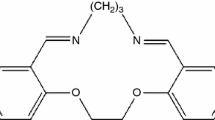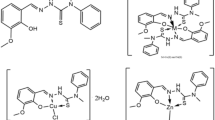Summary
For the first time, Co(II), Ni(II) and Zn(II) complexes have been synthesized involving an intermediate Schiff base, indane-1,3-dione-2-imine-N-acetic acid the condensed product of ninhydrin and glycine. These coloured complexes were characterised by elemental analysis, molar conductivity, thermogravimetric analyses/differential thermal analysis, infrared, magnetic susceptibility, NMR and electronic spectral studies. Mechanisms for their formation have been proposed. The experimental studies reveal that the complexes possess octahedral stereochemistry whereas the Schiff base behaves as a monobasic tridentate ligand. A molecular structure for the metal complexes is also proposed. A comparative study of the antimicrobial activity of ninhydrin and the corresponding metal complexes againstEscherichia coli, Proteus mirabilis, Staphylococcus aureus andStreptococcus faecalis has been undertaken and the results are discussed.
Similar content being viewed by others
References
Baker LCW, Mukherjee HG, Shyamali de (1985) Synthesis and characterisation of tritellurato-cobaltate(III) complex. J Indian Chem Soc 58:569–571
Baranwaal BP, Parashar GK, Mehrotra RC (1984) Synthesis and physico-chemical studies of some binuclear mixed carboxylates of copper(II). J Indian Chem Soc 61:923–925
Bellamy LJ (1975) The infrared spectra of complex molecules. Chapman and Hall, London
Bovey FA, Tiers GVD (1959) Proton NMR spectroscopy V. Studies of amino acids and peptides in trifluoroacetic acid. J Am Chem Soc 81:2870–2878
Chrisey LA, Sharidi Bonjar GH, Hecht SM (1988) DNA strand scission by (−)-epicatechin and procyanidin B2. J Am Chem Soc 110:644–646
Colthup NB, Daly LH (1964) Introduction to infrared and Raman spectroscopy. Academic Press, New York
Cyba HA (1968) US Patent 3398170
Dhakarey R, Saxena G (1987) Synthesis, spectral and magnetic studies of Ni(II) complexes with Schiff bases of heterocyclic aldehydes. J Indian Chem Soc 64:685–686
Friedman M, Sigel CW (1966) A kinetic study of the ninhydrin reaction. Biochemistry 5:478–484
Grove DC, Randall WA (1955) Assay methods of antibiotics. Medical Encyclopedia Inc, New York
Gupta HK, Mourya P, Dey AK (1982) Mannich bases as potential polydentate ligands: 2,5-bis(benzylaminomethyl) hydroquinone complexes. J Indian Chem Soc 5°:216–218
Holm RH, Everett GM Jr, Chakravorty A (1966) Metal complexes of Schiffs bases and β-keto amines. Prog Inorg Chem 7:104
Izard C (1960) Utilization of ninhydrin as an adjuvant of serological reaction in gel: application to the viruses of plants. Compt Rend 250:3906–3908
Jana AK, Sahoo B (1984) Tetranuclear metal complexes of copper(II) withm-bis(1,3,5-trioxohexyl)benzene andm-bis(1,3,5-trioxo-5-phenylpentyl)benzene and corresponding macrocyclic Schiff base complexes formed withO-phenylenediamine. J Indian Chem Soc 61:936–939
Kavanagh F (1972) Analytical microbiology 2nd edn. Academic Press, New York, pp 1–86
Kawerau E, Wieland T (1951) Conservation of amino acid chromatograms. Nature 168:77–78
Kondo K, Chiba W, Kawai F (1954) The mechanism of inhibition by ene-diol compounds, aminobenzene derivatives and ketone compounds. Bull Res Inst Food Sci 13:53–59
Lamothe PJ, McCormick PG (1972) Influence of acidity on the reaction of ninhydrin with amino acids. Anal Chem 44:821–825
Lever ABP (1984) Inorganic electronic spectroscopy, 2nd edn. Elsevier, Amsterdam, pp 507
MacFadyen DA (1950) On the mechanism of the reaction of ninhydrin with α-amino acids. J Biol Chem 186:1–12
Mahto CB (1981) Studies on the complexes of 3-hydroxy-2-naphthaldehyde thiosemicarbazone with some divalent and trivalent metal ions. J Indian Chem Soc 58:935–936
Mann CK, Vickers TJ, Gulick WM (1974) Instrumental analysis. Harper and Row, New York pp 537–543
McCaldin DJ (1960) The chemistry of ninhydrin. Chem Rev 60:39–51
Mordecai BR (1975) The chemistry of vicinal polyketones. Chem Rev 75:177–202
Nakamoto K (1970) Infrared spectra of inorganic and coordination compounds. Wiley Interscience, New York, pp 247–251
Nakamoto K, Morimoto Y, Martell AE (1963) Infrared spectra of aqueous solutions I. Metal chelate compounds of amino acids. J Am Chem Soc 83:4528–4536
Rao DS, Ganorkar MC (1981) Synthesis of some transition metal chelates of furfurylidene and 5-nitrofurfurylidene benzoylhydrazones as potential fungicides. J Ind Chem Soc 58:217–219
Sharma IB, Batra S, Balla S, Gupta RK (1986) Thermal decomposition of CeCl3 · 7H2O. J Ind Chem Soc 63:520–523
Sharma RK, Sharma CP, Sharma A (1987) Synthesis and spectroscopic investigations on bisdithio-carbamato complexes of di-p-tert-butyl-phenyl tin(IV). J Ind Chem Soc 64:205–208
Shrivastava VS, Bhasin LP, Saxena GC (1986) Spectral and magnetic and antibacterial studies of some newly synthesized Mn(H), Co(H), Ni(H) and Cu(II) complexes. J Ind Chem Soc 63:865–868
Singh B, Misra H (1986) Co(II), Ni(II), Cu(II), Zn(II), Cd(H) and dioxouranium(II) complexes of thiophene-2-aldehyde-4-phenyl thiosemicarbazone. J Ind Chem Soc 63:1069–1070
Smith JW (1970) Basic and Complexing properties. In: Patai S (ed) The chemistry of the carbon-nitrogen double bond. Interscience, New York, pp 239–240
Sorenson RJJ (1980) US Patent 4-221785
Sproessig M, Muecke H (1963) Inactivation of viruses by α-dicarbonyl compounds. Acta Virol 7:472–474
Tayean F, Faure F (1953) Ninhydrin and the antigen-antibody reaction. Bull Soc Chem Biol 35:1193–1199
Tiffany BD, Wright JB, Moffett RB, Heinzelman RV, Strube RE, Aspergren BD, Lincoln EH, White JL (1957) Antiviral compounds. I. Aliphatic glyoxals, α-hydroxy-aldehydes and related compounds. J Am Chem Soc 79:1682–1687
Tondon JP (1986) Synthesis of some novel boron Schiff base and allied derivatives. J Ind Chem Soc 63:451–459
Venkataraman VR, Kather MS, Mansoor I, Nagarajan S (1986) Nickel(H) and copper(H) complexes with 2′,4′-dihydroxy-5′-(4-methoxy)cinnamoyl-4-methoxy chalcone. J Ind Chem Soc 63:925–926
Yao HC (1964) Azohydrazone conversion II. The coupling of diazonium ion withβ-diketone. J Org Chem 29:2959–2963
Yuki H, Sano F, Takama S, Suzuki S (1966) Antiviral agents I. Relation between chemical reactivity of sulfhydryl reagents and their inactivating activity of adenovirus 5. Chem Pharm Bull (Tokyo) 14:139–146
Zlatkis A, Breitmaier E, Jung G (1973) A concise introduction to organic chemistry. McGraw Hill, New York
Author information
Authors and Affiliations
Rights and permissions
About this article
Cite this article
Koteswara Rao, N.S.R.R.M.M., Ram Reddy, M.G. Studies on the synthesis, characterisation and antimicrobial activity of new Co(II), Ni(II) and Zn(II) complexes of Schiff base derived from ninhydrin and glycine. Biol Metals 3, 19–23 (1990). https://doi.org/10.1007/BF01141172
Received:
Issue Date:
DOI: https://doi.org/10.1007/BF01141172




